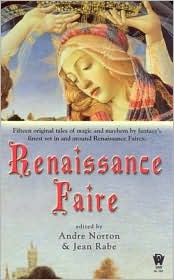 There’s nothing quite like a Renaissance Faire. The crowds, the jousting, the meat on a stick, the mangled accents, the lovely costumes and chainmail bikinis, the people playacting at a fantasized, idealized past. In this imaginative anthology, sixteen authors turn their creative attentions towards exploring what bizarre secrets and magical mysteries these Faires might hold. Now, apart from Mercedes Lackey’s Knight of Ghosts and Shadows, I can’t think of too many fantasy books to take advantage of the potential of Renn Faires, so it’s good to see someone giving the concept some in-depth consideration, if just because it’s perfect for a wide variety of takes, both serious and less-than-serious.
There’s nothing quite like a Renaissance Faire. The crowds, the jousting, the meat on a stick, the mangled accents, the lovely costumes and chainmail bikinis, the people playacting at a fantasized, idealized past. In this imaginative anthology, sixteen authors turn their creative attentions towards exploring what bizarre secrets and magical mysteries these Faires might hold. Now, apart from Mercedes Lackey’s Knight of Ghosts and Shadows, I can’t think of too many fantasy books to take advantage of the potential of Renn Faires, so it’s good to see someone giving the concept some in-depth consideration, if just because it’s perfect for a wide variety of takes, both serious and less-than-serious.
Elizabeth Ann Scarborough’s “Jewels Beyond Price” brings a little bit of Aladdin into the Faire, when a jeweler stumbles across a lamp-shaped lighter, complete with its own personal genie. Unfortunately, the lighter’s previous owner realizes his loss, and comes looking for it. It’s an interesting showdown, with royalty in attendance. Joe Haldeman’s “Diminished Chord” is somewhat morose, something of a ghostly romance with a not-so-happy ending. In “Splinter,” Kevin J. Anderson and Rebecca Moesta chronicle the tale of a pickpocket who’s about to lift more than he ever expected from one man’s pocket, an encounter which will change his life forcibly. It’s a morality tale, one that quite clearly lays out the consequences for doing the right thing and the wrong thing.
Robert E. Vardeman’s “A Time For Steel” looks at the beginning of a legend which will last for centuries, whose origins lie in modern times, and whose culmination lies in the Dark Ages. In Jayge Carr’s “Wimpin’ Wady,” an overzealous member of the Fae kidnaps the wrong child, earning the desperate ire of the child’s mother. Esther Friesner turns in what might very well be the funniest piece of the book, in “Marriage a la Mordred.” When some idle playacting accidentally binds one of the Fae to a teenage girl, the immortal Lord of Faerie learns to his dismay just how temperamental, stubborn, resourceful, and incomprehensible mortal teenagers can be. The results are hilarious, as always when Friesner turns her hand to comedy.
Roberta Gellis’ “Moses’ Miracles” looks at a billionaire and his faithful curator/librarian. It seems that they’ve acquired an item of great age and tremendous mystical importance, and an otherworldly race needs their help, but will the cost be too high to bear? Of all the stories in this book, this one is the one that most deserves to be followed up upon, as there’s clearly a lot more to be explored with these characters. Stephen Sullivan’s “Renaissance Fear” is one of the darkest pieces to be found here, looking at a young couple who become caught between the present and the past, with deadly consequences. Brian Hopkins’ The Land of the Awful Shadow” is an introspective story, flashing between childhood and adulthood for a couple of friends who share a number of secrets, and a bond which unites them across the decades.
As with any themed anthology, you’ll find a wide range, both in tone and in style. For the most part, Renaissance Faire is a nice collection of satisfying stories, sticking fairly close to the theme without being overly repetitive. I was rather pleased with the overall content.
